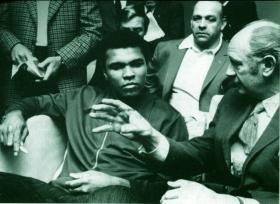From the files of the DIB…‘Ireland’s strongest man’
Published in 18th–19th - Century History, Issue 1 (Jan/Feb 2006), News, Volume 14 SUGRUE, Michael ‘Butty’ (1924–77), circus strongman, entrepreneur and boxing promoter, was born 27 July 1924 in Gortnascarry, near Killorglin, Co. Kerry, one of six children of Timothy Sugrue, a farmer, and his wife Eileen Reilly of Gortnascarry. Known as ‘Butty’ because of his squat and powerful stature, upon leaving school he was employed as a turf-cutter in the midlands, where he entertained fellow workers with demonstrations of his prodigious strength. He joined the army in the early 1940s and spent many hours in the gymnasium, developing his body in the hope of becoming a professional weightlifter. He later toured Ireland for a couple of years with Duffy’s Circus, billed as ‘Ireland’s strongest man’, challenging all comers to match his feats of strength, which included lifting four 56lb weights attached to a cart axle or dragging a cart filled with ten men around the big top with a rope clenched between his teeth. During the 1950s he became well known as a wrestler and later as a boxing promoter, famously fighting his friend Jack Doyle, ‘the gorgeous Gael’, in a wrestling match in his home town of Killorglin in 1953, and easily defeating him in the first round. He also promoted a number of touring shows, bringing boxers such as Henry Cooper and Joe Louis to rural Ireland.
SUGRUE, Michael ‘Butty’ (1924–77), circus strongman, entrepreneur and boxing promoter, was born 27 July 1924 in Gortnascarry, near Killorglin, Co. Kerry, one of six children of Timothy Sugrue, a farmer, and his wife Eileen Reilly of Gortnascarry. Known as ‘Butty’ because of his squat and powerful stature, upon leaving school he was employed as a turf-cutter in the midlands, where he entertained fellow workers with demonstrations of his prodigious strength. He joined the army in the early 1940s and spent many hours in the gymnasium, developing his body in the hope of becoming a professional weightlifter. He later toured Ireland for a couple of years with Duffy’s Circus, billed as ‘Ireland’s strongest man’, challenging all comers to match his feats of strength, which included lifting four 56lb weights attached to a cart axle or dragging a cart filled with ten men around the big top with a rope clenched between his teeth. During the 1950s he became well known as a wrestler and later as a boxing promoter, famously fighting his friend Jack Doyle, ‘the gorgeous Gael’, in a wrestling match in his home town of Killorglin in 1953, and easily defeating him in the first round. He also promoted a number of touring shows, bringing boxers such as Henry Cooper and Joe Louis to rural Ireland.
Emigrating to London in the early 1960s, he became a very successful publican. He made several appearances on television displaying his strength, and attracted publicity through a series of stunts, such as staging an indoor ‘Puck Fair’, with attendant difficulties in importing a goat from Kerry, and persuading one of his barmen to spend 61 days in a coffin buried in the garden of one of his pubs.
His most ambitious promotion was a fight between Muhammad Ali—probably the most instantly recognisable person in the world at the time—and Al ‘Blue’ Lewis at Croke Park, Dublin, in 1972. Although the promotion was greeted with some scepticism in Dublin, and Butty’s idiosyncratic management style seemed to conform to the stereotype of the stage Irishman, the fight took place on 19 July 1972, with Ali winning in the eleventh round. However, the organisation of the event was a shambles. Among its more farcical elements was the fact that boxing gloves had to be flown in from London at the last minute because no one had thought to supply them. While Ali’s visit to Ireland captured the public imagination, the fight did not, and the official attendance of 18,725 included at least 7,000 who got in free, and fell far short of the break-even figure of 30,000. Sugrue, who, though only co-promoter with American Harold Conrad, financed the entire venture, always maintained that he had not lost money, but others estimated that he was probably £20,000 out of pocket. The fact that there was no profit meant that the nominated charity, loosely defined as ‘the mentally handicapped children of Ireland’, received nothing.
Despite Sugrue’s reputation as a master at garnering cheap publicity and delivering less than he promised, bringing Ali to Ireland was probably the biggest sporting promotion that Ireland had ever seen. Sugrue’s achievement is even more remarkable when one considers that it happened against the backdrop of some of the worst violence in Northern Ireland and in the year in which the Scottish and Welsh rugby teams refused to travel to Dublin for safety reasons. Sugrue’s friendship with Jack Doyle, often cynically seen as his entrée into celebrity circles, was genuine, and he regularly paid an almost destitute Doyle to sing in his pubs. He also discreetly assisted many Irish immigrants in London. He died on 16 October 1977, collapsing in one of his pubs, the Wellington at Shepherd’s Bush, while carrying a fridge upstairs. He was buried in Killorglin.
Selected sources:
D. Hannigan, The big fight (2002).
R. Smith, Urbi et Orbi and all that (1995).
M. Taub, Jack Doyle: fighting for love (1990).
Jim Shanahan is an editorial assistant with the Dictionary of Irish Biography.


















